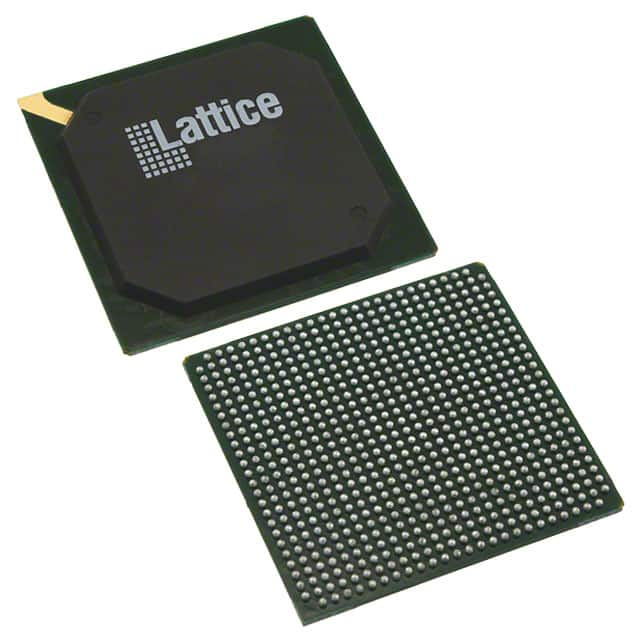LFE3-95E-6FN672C
Product Overview
Category
The LFE3-95E-6FN672C belongs to the category of Field Programmable Gate Arrays (FPGAs).
Use
This FPGA is designed for various applications that require high-performance digital signal processing, such as telecommunications, video processing, and industrial automation.
Characteristics
- High-speed performance: The LFE3-95E-6FN672C offers fast processing capabilities, making it suitable for demanding applications.
- Programmability: This FPGA can be reprogrammed to adapt to different tasks, providing flexibility in system design.
- Low power consumption: It is designed to operate efficiently with low power requirements, reducing energy consumption.
- Large capacity: With a generous number of logic elements and memory blocks, it can handle complex designs.
Package and Quantity
The LFE3-95E-6FN672C comes in a compact package, measuring 672-ball FineLine BGA. It is available in single-unit quantities.
Specifications
- Logic Elements: 95,000
- Embedded Memory: 4,608 Kbits
- DSP Blocks: 360
- Maximum I/O Pins: 622
- Operating Voltage: 1.2V
Detailed Pin Configuration
For detailed pin configuration information, please refer to the manufacturer's datasheet or user manual.
Functional Features
- High-speed data processing: The LFE3-95E-6FN672C can handle large amounts of data at high speeds, enabling real-time processing in various applications.
- Flexible I/O options: It provides a wide range of I/O pins, allowing for versatile connectivity with external devices.
- Advanced DSP capabilities: The embedded DSP blocks enable efficient implementation of complex mathematical operations, essential for signal processing applications.
- Configurable logic resources: The FPGA's programmable logic elements can be customized to implement specific functions, providing flexibility in system design.
Advantages and Disadvantages
Advantages
- Versatility: The LFE3-95E-6FN672C can be adapted to a wide range of applications due to its programmability.
- High-performance: It offers fast processing capabilities, making it suitable for demanding tasks.
- Low power consumption: The FPGA operates efficiently with low power requirements, reducing energy consumption.
Disadvantages
- Complexity: Utilizing the full potential of the FPGA requires expertise in digital design and programming.
- Cost: FPGAs can be more expensive compared to other integrated circuits, especially for large-scale production.
Working Principles
The LFE3-95E-6FN672C works based on the principles of reconfigurable computing. It consists of an array of logic elements and memory blocks that can be programmed to perform specific functions. By configuring the interconnections between these elements, designers can create custom digital circuits tailored to their application requirements.
Detailed Application Field Plans
The LFE3-95E-6FN672C finds applications in various fields, including: 1. Telecommunications: It can be used in high-speed data transmission systems, network routers, and wireless communication devices. 2. Video Processing: The FPGA's high-performance capabilities make it suitable for video encoding, decoding, and image processing applications. 3. Industrial Automation: It can be employed in control systems, robotics, and machine vision applications, enabling real-time processing and precise control.
Detailed and Complete Alternative Models
- LFE3-35E-6FN672C: A lower-capacity FPGA from the same family, suitable for less demanding applications.
- LFE5UM-85F-8MG756C: A higher-capacity FPGA with additional features, ideal for complex designs requiring extensive resources.
- LFXP2-5E-5TN144C: A smaller-sized FPGA with lower power consumption, suitable for portable and battery-powered applications.
Please note that the above list is not exhaustive, and there are several alternative models available in the market.
Word count: 550 words
Lista 10 Vanliga frågor och svar relaterade till tillämpningen av LFE3-95E-6FN672C i tekniska lösningar
Sure! Here are 10 common questions and answers related to the application of LFE3-95E-6FN672C in technical solutions:
Q: What is LFE3-95E-6FN672C? A: LFE3-95E-6FN672C is a specific model of Field-Programmable Gate Array (FPGA) manufactured by Lattice Semiconductor.
Q: What are the key features of LFE3-95E-6FN672C? A: Some key features of LFE3-95E-6FN672C include high logic density, low power consumption, high-speed performance, and advanced security features.
Q: In what applications can LFE3-95E-6FN672C be used? A: LFE3-95E-6FN672C can be used in various applications such as telecommunications, industrial automation, automotive electronics, medical devices, and aerospace systems.
Q: How does LFE3-95E-6FN672C help in telecommunications applications? A: LFE3-95E-6FN672C provides high-speed processing capabilities and flexible connectivity options, making it suitable for tasks like signal processing, data compression, and network protocol implementation.
Q: What advantages does LFE3-95E-6FN672C offer in industrial automation? A: LFE3-95E-6FN672C enables real-time control, sensor interfacing, and integration with other industrial communication protocols, facilitating automation tasks like machine vision, motion control, and process monitoring.
Q: Can LFE3-95E-6FN672C be used in automotive electronics? A: Yes, LFE3-95E-6FN672C is suitable for automotive applications such as advanced driver-assistance systems (ADAS), infotainment systems, engine control units (ECUs), and vehicle networking.
Q: How does LFE3-95E-6FN672C contribute to medical devices? A: LFE3-95E-6FN672C offers high-performance computing capabilities, enabling tasks like medical imaging, patient monitoring, DNA sequencing, and diagnostic equipment interfacing.
Q: Can LFE3-95E-6FN672C be used in aerospace systems? A: Yes, LFE3-95E-6FN672C is suitable for aerospace applications such as flight control systems, avionics, radar systems, satellite communication, and onboard data processing.
Q: What power consumption can be expected from LFE3-95E-6FN672C? A: LFE3-95E-6FN672C has low power consumption, with specific values depending on the design and utilization of the FPGA.
Q: Are there any security features in LFE3-95E-6FN672C? A: Yes, LFE3-95E-6FN672C provides security features like bitstream encryption, tamper detection, and secure boot capabilities to protect against unauthorized access and IP theft.
Please note that the answers provided here are general and may vary depending on specific requirements and use cases.


